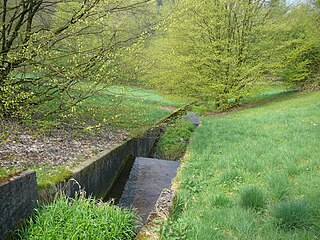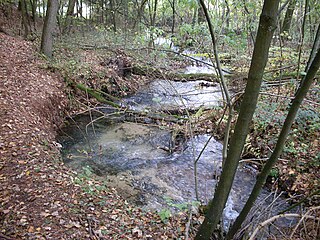
Aa is a river of North Rhine-Westphalia, Germany. It is 7.4 kilometres (4.6 mi) long and is a left tributary of the Möhne in Brilon. The river has a watershed of 23.071 square kilometres (8.908 sq mi).

Alte Emscher is a river of North Rhine-Westphalia, Germany. It flows into the Rhine near Hamborn (Duisburg). It is the former lower course of the Emscher.

The Anger is a right tributary of the Rhine in North Rhine-Westphalia, Germany. It flows through Wülfrath and Ratingen, and discharges into the Rhine in Angerhausen, a district in the southern part of Duisburg.
Asbeke is a river of North Rhine-Westphalia, Germany. It flows into the Eickumer Mühlenbach near Herford.
Auelsbach is a river of North Rhine-Westphalia, Germany. It flows into the Agger in Lohmar.

Auer Bach is a small river of North Rhine-Westphalia, Germany. It flows into the Wupper in Wuppertal.
Bachseifen is a small river of North Rhine-Westphalia, Germany. It flows into the Heller near Burbach.

Bärenbach is a small river of North Rhine-Westphalia, Germany. It is 2.2 km long and flows into the Furlbach near Stukenbrock.

Belgenbach is a river of North Rhine-Westphalia, Germany. It flows into the Rur near Monschau.

Bentgraben is a small river of North Rhine-Westphalia, Germany. It flows into the Werre near Bad Salzuflen.
Berghauser Bach is a small river of North Rhine-Westphalia, Germany. It flows into the Casumer Bach near Borgholzhausen.
Bermecke is a stream in North Rhine-Westphalia, Germany. It is a left tributary of the river Heve.

Borstenbach is a river of North Rhine-Westphalia, Germany. It flows into the Weser in Bad Oeynhausen.

Buchheller is a river of North Rhine-Westphalia, Germany. It is 8.9 km long and flows into the Heller near Burbach.
Casumer Bach is a river of North Rhine-Westphalia, Germany. It is approximately 7.2 km long and flows directly into the Hessel east of Versmold.

Darmühlenbach is a river of North Rhine-Westphalia, Germany. It is 7.8 km long and flows into the Else near Bünde.

Dettmersbach is a small river of North Rhine-Westphalia, Germany. It is 5.3 km long and flows into the Ems near Gütersloh.

Eistringhauser Bach is a small river of North Rhine-Westphalia, Germany. It flows into the Uelfe near Radevormwald.
Erlenbach is a small river of North Rhine-Westphalia, Germany. It is 4.7 km long and flows into the Bever near Radevormwald.
Fülsenbecke is a small river of North Rhine-Westphalia, Germany. It flows into the Aa near Brilon.













